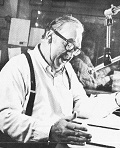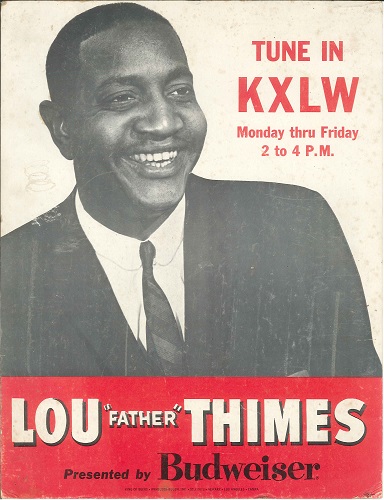Radio Articles
Ed Wilson Had the Franchise On Folksy
Ed Wilson was big in St. Louis radio for a number of years. And he was very big in person too, tipping 300 pounds at several points in his life.
 When he joined KWK radio May 25, 1942, the country was involved in a far-away war. He had been heard previously over one of the NBC networks broadcasting from WLS in Chicago. His friendly, folksy patter kept his listeners in the St. Louis area company as he broadcast from the KWK studios in the Chase Hotel. Spinning records was always an integral part of his radio shows, but Wilson’s signature trait was his ability to talk with his listeners, just as though they were sitting across the kitchen table from him. Under the ownership of the Convey family, KWK had long been a radio staple in the market, providing a variety of entertainment. Wilson’s personal approach was a perfect fit.
When he joined KWK radio May 25, 1942, the country was involved in a far-away war. He had been heard previously over one of the NBC networks broadcasting from WLS in Chicago. His friendly, folksy patter kept his listeners in the St. Louis area company as he broadcast from the KWK studios in the Chase Hotel. Spinning records was always an integral part of his radio shows, but Wilson’s signature trait was his ability to talk with his listeners, just as though they were sitting across the kitchen table from him. Under the ownership of the Convey family, KWK had long been a radio staple in the market, providing a variety of entertainment. Wilson’s personal approach was a perfect fit.
 And in the pre-rock-and-roll days, his popular music had its share of young listeners, as well as housewives. In 1957, that appeal to youth was instrumental in his being hired as the first host of KSD-TV’s “St. Louis Hop.” His TV career was short-lived, but it was a stepping stone to his next radio gig, KSD, which he joined in August of 1958.
And in the pre-rock-and-roll days, his popular music had its share of young listeners, as well as housewives. In 1957, that appeal to youth was instrumental in his being hired as the first host of KSD-TV’s “St. Louis Hop.” His TV career was short-lived, but it was a stepping stone to his next radio gig, KSD, which he joined in August of 1958.
And then something happened. Ed Wilson was bitten by the wandering bug. It’s not known why he came to the conclusion he did, but Wilson decided it was time to make his move in 1960 to head for Hollywood. He and KSD reached an agreement whereby Ed would record his program in California and put the tapes on a plane, assuring St. Louis delivery in time to be aired the following day. It was an arrangement that was bound to fail, and when it did, Ed Wilson’s voice left the St. Louis airwaves.
As Globe-Democrat TV-Radio editor Pete Rahn wrote, “Personally, I’m sorry to hear that the familiar voice of Ed Wilson will no longer be coming into our homes and autos…Like him or not, you must agree that Wilson’s shows were always high class. Pleasant music and chatter. Maybe a bit old hat at times, but always clean.”
 Within a couple years the Wilson family was back in St. Louis, the California effort having failed. He joined WIL in 1962, quitting two years later when management changed, making a move to WEW. After six years there he returned to WIL, a job he held until his death from a heart attack in February of 1975.
Within a couple years the Wilson family was back in St. Louis, the California effort having failed. He joined WIL in 1962, quitting two years later when management changed, making a move to WEW. After six years there he returned to WIL, a job he held until his death from a heart attack in February of 1975.
In his nearly 30 years in St. Louis radio, Ed Wilson wisely cultivated a lucrative side income stream doing voiceover work for commercials. He also tried his hand at early syndication of radio features, but the reality was that Ed was appreciated for what he did in St. Louis radio and never caught on outside of the market.
At one point while at KWK, he received over 16,000 listener letters in one week. His local programs produced direct results for his advertisers, and in the business of radio, that is what really mattered.
 About three years ago, Roy Queen, the Lone Singer, decided that he wasn’t quite satisfied with life in Ironton, Missouri and wanted things to happen. He took a couple of bicycle tires and traded them for a 22 rifle but found that wasn’t quite what he wanted.
About three years ago, Roy Queen, the Lone Singer, decided that he wasn’t quite satisfied with life in Ironton, Missouri and wanted things to happen. He took a couple of bicycle tires and traded them for a 22 rifle but found that wasn’t quite what he wanted.
